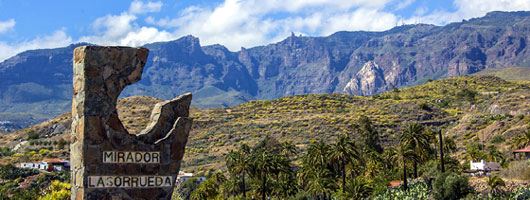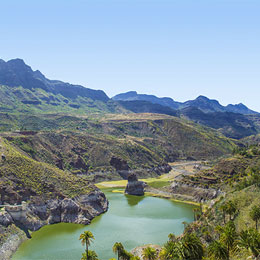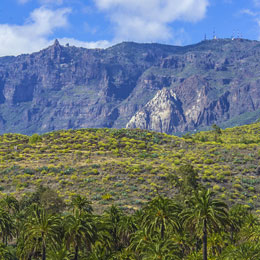Along this stretch of the Barranco de Tirajana the close knit relationship between the palm groves and the country folk becomes quite apparent. The Canary palm tree groves (Phoenix canariensis) correspond to the original vegetation in the ravine and surrounding areas; here the weather conditions are milder, as there is shade and shelter from the wind for the crops, as well as providing an important source of foodstuff for fauna.

On the one hand, its leaves serve as food for sheep and goat flocks, while on the other, its little date palms known in the Canaries as ‘támaras’, provide food for pigs; then from its trunk, wooden beams have traditionally, since pre Hispanic times, been obtained for the construction of roofs, as well as substitute wooden planks for building furniture and appliances. The trunk was also carved out from the inside to provide space for beehives.
The leaves meanwhile, apart from their simple rustic use as fencing or sun shelter, have been used since time immemorial as the raw material for exquisite craftwork in everyday items in rural areas. Both matting and basket weaving have been main manufacturing activities, for their toughness, as is the case of the great rock baskets used in the loading and transporting of stones, and “serones”, or whicker bags. In Santa Lucía there are still some craftsmen and women who specialize in producing high quality whicker ware, as they make full use of the reeds and bulrushes that spring up along the ravine bed.


The Presa de Tirajana reservoir, also known as the Presa de la Sorrueda, was finalized in 1974, being one of the very few in Gran Canaria to be made up of odd materials: it is a clay rockfill embankment, with a maximum height from its foundation reaching some 74 m., with a capacity of 380.000 m3. It has its own peculiar tunnel overflow, rounded with no gates, known as the Morning Glory (an original English name given to the ornamental Ipomoea plants, related to the sweet potato, which sprout up and have trumpet and funnel shaped flowers).
The whole area to the west of this gully, with the exception of its narrow coastal strip, forms part of the World Biosphere Reserve of Gran Canaria, as declared by UNESCO on 29th June 2005.
